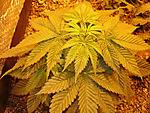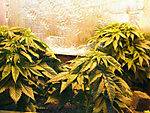J
JackTheGrower
big trichs on that middle bud!
i repot for the final time at the same time i put them to 12/12,or perhaps a week before. i put guano, seaweed and rock phosphate in the soil mix and then don't feed them until they start to look hungry, sometimes about halfway through ranging to never.then i use biobiz bloom, half strength perhaps every other watering.
many plants in general grow leaves when in soil rich in nutrients, you need to make them a little less comfortable to get them to flower or fruit well. tomatoes for instance set their first truss quicker if kept in a pot rather than planted out early.
I'm going to use the "you need to make them a little less comfortable to get them to flower or fruit well" as it's the Nth time someone has said that some kind of stress makes for a better yield.
About the middle picture I believe Azomite helped make them so nice.
I don't know that biobiz bloom.. doesn't require microbial action for plant uptake I am guessing.
About those leaves, yeah I get large foliage on a 14 hour day under 1k hps with that medical strain, Glad.


Also root and stalk development was excellent.
I'm the odd man with my planter box I figure.. I saw Soma's boxes and made my grow room a super Soma style box.
I just am not sure on knowing how much nutrients are used and how much is needed for a given volume of "soil." That would be some useful info.
Anyone know the amounts of nutrient uptake for cannabis? I'm concerned now that I shouldn't apply much P & K for the next season.. Oh hell i probably don't need to compost the soil after this next grow anyway.. It's probably good for at least two seasons.
From that Soy bean study residual P & K in the next season is still good. I'll perhaps just scratch some Guano in the soil and call it good.
Jack





